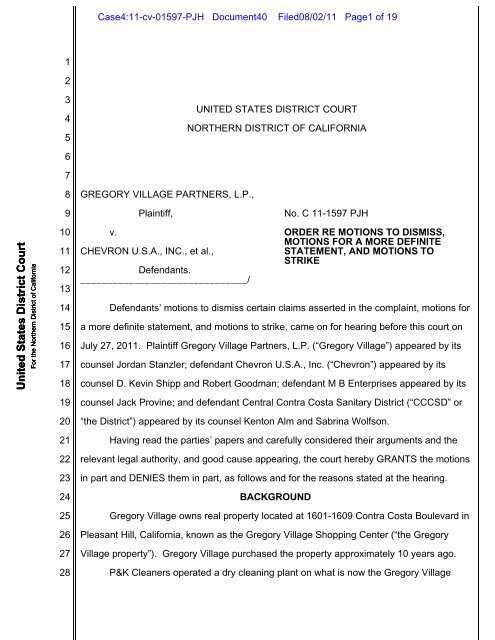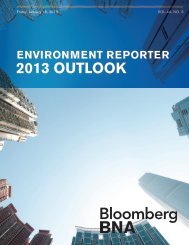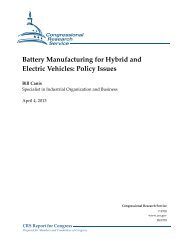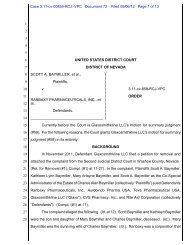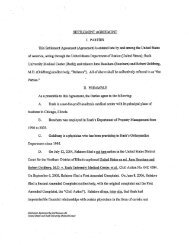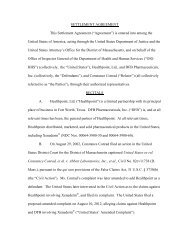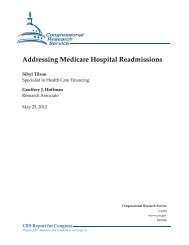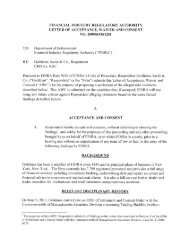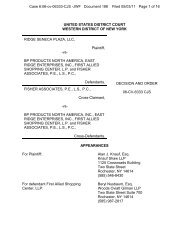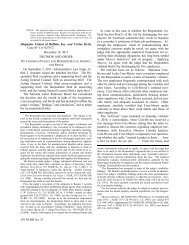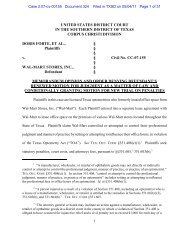G:\PJHALL\ORDERS\11\Gregory Village Partners v. Chevron ... - BNA
G:\PJHALL\ORDERS\11\Gregory Village Partners v. Chevron ... - BNA
G:\PJHALL\ORDERS\11\Gregory Village Partners v. Chevron ... - BNA
- No tags were found...
Create successful ePaper yourself
Turn your PDF publications into a flip-book with our unique Google optimized e-Paper software.
Case4:11-cv-01597-PJH Document40 Filed08/02/11 Page1 of 1912345UNITED STATES DISTRICT COURTNORTHERN DISTRICT OF CALIFORNIA6789GREGORY VILLAGE PARTNERS, L.P.,Plaintiff,No. C 11-1597 PJHUnited States District CourtFor the Northern District of California101112131415161718v. ORDER RE MOTIONS TO DISMISS,MOTIONS FOR A MORE DEFINITECHEVRON U.S.A., INC., et al.,STATEMENT, AND MOTIONS TOSTRIKEDefendants._______________________________/Defendants’ motions to dismiss certain claims asserted in the complaint, motions fora more definite statement, and motions to strike, came on for hearing before this court onJuly 27, 2011. Plaintiff Gregory <strong>Village</strong> <strong>Partners</strong>, L.P. (“Gregory <strong>Village</strong>”) appeared by itscounsel Jordan Stanzler; defendant <strong>Chevron</strong> U.S.A., Inc. (“<strong>Chevron</strong>”) appeared by itscounsel D. Kevin Shipp and Robert Goodman; defendant M B Enterprises appeared by its19202122232425262728counsel Jack Provine; and defendant Central Contra Costa Sanitary District (“CCCSD” or“the District”) appeared by its counsel Kenton Alm and Sabrina Wolfson.Having read the parties’ papers and carefully considered their arguments and therelevant legal authority, and good cause appearing, the court hereby GRANTS the motionsin part and DENIES them in part, as follows and for the reasons stated at the hearing.BACKGROUNDGregory <strong>Village</strong> owns real property located at 1601-1609 Contra Costa Boulevard inPleasant Hill, California, known as the Gregory <strong>Village</strong> Shopping Center (“the Gregory<strong>Village</strong> property”). Gregory <strong>Village</strong> purchased the property approximately 10 years ago.P&K Cleaners operated a dry cleaning plant on what is now the Gregory <strong>Village</strong>
Case4:11-cv-01597-PJH Document40 Filed08/02/11 Page2 of 1912345678910property, from the mid-1960s through approximately 1991. As required by the RegionalWater Quality Control Board, Gregory <strong>Village</strong> has been investigating soil and groundwatercontamination that allegedly resulted from P&K Cleaners’ use and disposal of solvents.Gregory <strong>Village</strong> asserts that chlorinated solvents, including PCE (tetrachlorethene)and TCE (trichloroethylene) and their breakdown products, as well as petroleumhydrocarbons and related materials and their breakdown products, have been detected ingroundwater and soil vapor on or near the Gregory <strong>Village</strong> property.The Gregory <strong>Village</strong> property is located downhill from real property located at 1705-1709 Contra Costa Boulevard (“the <strong>Chevron</strong> property”) which is currently owned by M BEnterprises. The <strong>Chevron</strong> property was originally two parcels (“the Northern parcel” andUnited States District CourtFor the Northern District of California1112131415161718“the Southern parcel”).From approximately 1950 until 1986, <strong>Chevron</strong> (through Standard Oil) leased theNorthern parcel from the owner. There was a service station on the parcel, and in 1971,<strong>Chevron</strong> removed the existing service station and constructed a new service station with anauto repair facility. Standard Oil/<strong>Chevron</strong> sub-leased the Northern Parcel to a third party,which operated the service station.A dry cleaner was allegedly in operation on the Southern Parcel from at least 1981until 1986. It is not clear from the complaint who the owner of the Southern Parcel was.19202122232425262728According to Gregory <strong>Village</strong>, <strong>Chevron</strong> states that all dry cleaning equipment was removedfrom the Southern Parcel by December 1, 1986.In December 1986, <strong>Chevron</strong> purchased both the Northern parcel and the Southernparcel. At that point, or shortly thereafter, <strong>Chevron</strong> combined the two parcels into a singleparcel, which it sold to M B Enterprises in March 2003.There is currently a <strong>Chevron</strong> service station located on the <strong>Chevron</strong> property. Theservice station is operated by M B Enterprises. Gregory <strong>Village</strong> asserts that chlorinatedsolvents and hydrocarbons and related products have been detected in groundwater andsoil vapor on or near the <strong>Chevron</strong> property.Gregory <strong>Village</strong> also alleges that pollution from the former dry cleaner (chlorinated2
Case4:11-cv-01597-PJH Document40 Filed08/02/11 Page3 of 1912345678910solvents) has been found in the groundwater on the <strong>Chevron</strong> property by <strong>Chevron</strong>’sconsultants, and that <strong>Chevron</strong> was aware of this pollution in 1986 when it purchased thetwo parcels, and that as of 1988, it was aware of chlorinated solvents in the soil vapor inthe <strong>Chevron</strong> property.Gregory <strong>Village</strong> asserts that <strong>Chevron</strong> began groundwater remediation for petroleumrelatedcompounds in 1991, and that the remediation system was shut down in 1996.Nevertheless, according to Gregory <strong>Village</strong>, chlorinated solvents continued to be detectedboth on and off the <strong>Chevron</strong> property.In December 2009, Gregory <strong>Village</strong>’s consultant conducted an investigation of thegroundwater and found high concentrations of chlorinated solvents, and also foundUnited States District CourtFor the Northern District of California1112131415161718petroleum hydrocarbons. On April 1, 2010, representatives from Gregory <strong>Village</strong> met withrepresentatives from <strong>Chevron</strong>. At that time Gregory <strong>Village</strong> allegedly provided <strong>Chevron</strong>with information demonstrating the extent of the pollution.The <strong>Chevron</strong> property connects with a sewer line that runs northward anddownstream past the Gregory <strong>Village</strong> property, and into the residential neighborhood thatlies to the north of the Gregory <strong>Village</strong> property (“the Neighborhood”). This sewer line wasallegedly installed, and is owned and/or operated by, CCCSD. Gregory <strong>Village</strong> asserts thatchlorinated solvents have been detected in groundwater and soil vapor in the19202122232425262728Neighborhood, located north and west of the Gregory <strong>Village</strong> property. Gregory <strong>Village</strong>alleges that based on available data, the above-described sewer line is a source of thesevarious off-site detections of pollution.Gregory <strong>Village</strong> alleges that between 2005 and 2008, CCCSD performed a closedcircuit television inspection of the sewer line between the <strong>Chevron</strong> property and theNeighborhood. This inspection showed that the sewer line had sags, root penetration, andat least one separated joint – all of which (according to Gregory <strong>Village</strong>) are areas in whichleaks will continue to occur. Gregory <strong>Village</strong> also asserts that a key portion of the sewerline (near the Neighborhood) was never inspected. Gregory <strong>Village</strong> claims that CCCSDknew that dry cleaners and service stations were using the sewers to discharge hazardous3
Case4:11-cv-01597-PJH Document40 Filed08/02/11 Page4 of 1912345678910substances, and failed to use due care to ensure that hazardous substances were notreleased into the environment.Gregory <strong>Village</strong> also alleges that as the owner and operator of a service station onthe <strong>Chevron</strong> property, M B Enterprises has contributed to the contamination of the Gregory<strong>Village</strong> property and the Neighborhood by discharging petroleum products into thesubsurface of the <strong>Chevron</strong> property through the normal course of its operation of a servicestation. Gregory <strong>Village</strong> claims that M B Enterprises has failed to make any effort to stopthe migration of the PCE and TCE from the <strong>Chevron</strong> property into the Neighborhood.Gregory <strong>Village</strong> filed this action on April 1, 2011, alleging 11 causes of action –(1) a claim under CERCLA § 107(a)(1-4)(B), 42 U.S.C. § 9607(a), against all defendants;United States District CourtFor the Northern District of California1112131415161718(2) a claim under the Resources Conservation and Recovery Act (“RCRA”), 42 U.S.C.§ 6972(a)(1)(B), against all defendants; (3) a claim for declaratory relief under federal law,against all defendants; (4) a claim seeking response costs under the Carpenter-Presley-Tanner Hazardous Substance Account Act (“HSAA”), California Health & Safety Code§ 25300, et seq., against M B Enterprises and <strong>Chevron</strong>; (5) a claim of comparableequitable indemnity under state law, against all defendants; (6) a claim of declaratory reliefunder state law, against all defendants; (7) a claim for attorneys’ fees under CaliforniaCode of Civil Procedure § 1021.5, against all defendants; and (8)-(11) common law claims19202122232425262728of public nuisance; trespass; waste; and negligence, against all defendants.All three defendants have filed motions to dismiss. <strong>Chevron</strong> argues that theCERCLA/HSAA, RCRA, nuisance, trespass, waste, and negligence causes of actionshould be dismissed for failure to state a claim, or, in the alternative, that the court shouldorder Gregory <strong>Village</strong> to provide a more definite statement. <strong>Chevron</strong> also contends that thecause of action for attorney’s fees should be stricken because Civil Procedure Code§ 1021.5 does not create an independent cause of action; and that the prayer for attorney’sfees and costs should also be stricken because fees and costs are not recoverable inactions brought under CERCLA and HSAA, and because the common law causes of actiondo not provide for recovery of attorney’s fees.4
Case4:11-cv-01597-PJH Document40 Filed08/02/11 Page5 of 1912345678910M B Enterprises filed a joinder in <strong>Chevron</strong>’s motion, and a motion seeking dismissalof all eleven causes of action asserted against M B Enterprises and <strong>Chevron</strong> (even though<strong>Chevron</strong> seeks dismissal of only eight of the eleven causes of action), or, in the alternative,a more definite statement, plus an order striking the prayer for attorney’s fees and costs.CCCSD seeks a more definite statement as to the CERCLA cause of action, andargues that the court lacks subject matter jurisdiction over the RCRA cause of actionbecause Gregory <strong>Village</strong> did not comply with the 90-day notice requirement. CCCSD alsocontends that the RCRA cause of action fails to state a claim.In addition, CCCSD argues that the trespass and waste claims are barred becauseCCCSD is immune under California Government Code § 815; that the nuisance, trespass,United States District CourtFor the Northern District of California1112131415161718waste, and equitable indemnity causes of action fail because they are not pled withparticularity as required under the California Tort Claims Act; that the equitable indemnityclaim is premature because Gregory <strong>Village</strong> has not been served with a complaint givingrise to such a claim; that the nuisance and waste claims should be dismissed because theyare inadequately pled; and that the nuisance claim also fails because it is untimely andseeks damages beyond the one-year period allowed under the California GovernmentCode.DISCUSSION19202122232425262728A. Legal Standards1. Motions to Dismiss (Rule 12(b)(1))Federal courts are courts of limited jurisdiction, possessing only that powerauthorized by Article III of the United States Constitution and statutes enacted by Congresspursuant thereto. See Bender v. Williamsport Area Sch. Dist., 475 U.S. 534, 541 (1986).Thus, federal courts have no power to consider claims for which they lack subject-matterjurisdiction. See Chen-Cheng Wang ex rel. United States v. FMC Corp., 975 F.2d 1412,1415 (9th Cir. 1992). The court is under a continuing duty to dismiss an action whenever itappears that the court lacks jurisdiction. Id.; see also Spencer Enters., Inc. v. UnitedStates, 345 F.3d 683, 687 (9th Cir. 2003); Attorneys Trust v. Videotape Computers Prods.,5
Case4:11-cv-01597-PJH Document40 Filed08/02/11 Page6 of 1912345678910Inc., 93 F.3d 593, 594-95 (9th Cir. 1996).The burden of establishing that a cause lies within this limited jurisdiction rests uponthe party asserting jurisdiction. Kokkonen v. Guardian Life Ins. Co. of America, 511 U.S.375, 377 (1994). Thus, in the present action, petitioners bear the burden of demonstratingthat subject matter jurisdiction exists over this complaint. See, e.g., Tosco Corp. v.Communities for a Better Env't, 236 F.3d 495, 499 (9th Cir. 2001).On a motion to dismiss pursuant to Rule 12(b)(1), the applicable standard turns onthe nature of the jurisdictional challenge. A defendant may either challenge jurisdiction onthe face of the complaint or provide extrinsic evidence demonstrating lack of jurisdiction onthe facts of the case. White v. Lee, 227 F.3d 1214, 1242 (9th Cir. 2000). In evaluating aUnited States District CourtFor the Northern District of California1112131415161718facial attack on jurisdiction, the court must accept the factual allegations in plaintiff'scomplaint as true. See Miranda v. Reno, 238 F.3d 1156, 1157 n. 1 (9th Cir. 2001).A motion to dismiss for lack of subject matter jurisdiction may also be a “speakingmotion” in which the defendant actually challenges the existence of subject matterjurisdiction. In such a case, “[n]o presumptive truthfulness attaches to plaintiff’s allegations,and the existence of disputed material facts will not preclude the trial court from evaluatingfor itself the merits of jurisdictional claims.” Thornhill Publ’g v. Gen. Tel. & Elec. Corp.,594 F.2d 730, 733 (9th Cir. 1979). Moreover, the plaintiff, who bears the burden of proof19202122232425262728that jurisdiction does in fact exist, must establish jurisdiction with evidence from othersources. See Schwarzer, Tashima & Wagstaffe, Federal Civil Procedure Before Trial(2011) § 9:86.2. Motions to Dismiss (Rule 12(b)(6))A motion to dismiss under Rule 12(b)(6) tests for the legal sufficiency of the claimsalleged in the complaint. Ileto v. Glock, Inc., 349 F.3d 1191, 1199-1200 (9th Cir. 2003).Review is limited to the contents of the complaint. Allarcom Pay Television, Ltd. v. Gen.Instrument Corp., 69 F.3d 381, 385 (9th Cir. 1995). To survive a motion to dismiss forfailure to state a claim, a complaint generally must satisfy only the minimal notice pleadingrequirements of Federal Rule of Civil Procedure 8.6
Case4:11-cv-01597-PJH Document40 Filed08/02/11 Page7 of 1912345678910Rule 8(a)(2) requires only that the complaint include a “short and plain statement ofthe claim showing that the pleader is entitled to relief.” Fed. R. Civ. P. 8(a)(2). Specificfacts are unnecessary – the statement need only give the defendant “fair notice of the claimand the grounds upon which it rests.” Erickson v. Pardus, 551 U.S. 89, 93 (2007) (citingBell Atlantic Corp. v. Twombly, 550 U.S. 544, 555 (2007)).All allegations of material fact are taken as true. Id. at 94. However, legallyconclusory statements, not supported by actual factual allegations, need not be accepted.See Ashcroft v. Iqbal, 556 U.S. __, 129 S.Ct. 1937, 1949-50 (2009). A plaintiff's obligationto provide the grounds of his entitlement to relief “requires more than labels andconclusions, and a formulaic recitation of the elements of a cause of action will not do.”United States District CourtFor the Northern District of California1112131415161718Twombly, 550 U.S. at 555 (citations and quotations omitted). Rather, the allegations in thecomplaint “must be enough to raise a right to relief above the speculative level.” Id.A motion to dismiss should be granted if the complaint does not proffer enough factsto state a claim for relief that is plausible on its face. See id. at 558-59. “[W]here thewell-pleaded facts do not permit the court to infer more than the mere possibility ofmisconduct, the complaint has alleged – but it has not ‘show[n]’ – ‘that the pleader isentitled to relief.’” Iqbal, 556 U.S. __, 129 S.Ct. at 1950.In addition, when resolving a motion to dismiss for failure to state a claim, the court19202122232425262728may not generally consider materials outside the pleadings, although the court mayconsider a matter that is properly the subject of judicial notice. Lee v. City of Los Angeles,250 F.3d 668, 688-89 (9th Cir. 2001); see also Mack v. South Bay Beer Distributors, Inc.,798 F.2d 1279, 1282 (9th Cir. 1986) (on a motion to dismiss, a court may properly lookbeyond the complaint to matters of public record and doing so does not convert a Rule12(b)(6) motion to one for summary judgment). Additionally, the court may considerexhibits attached to the complaint, see Hal Roach Studios, Inc. V. Richard Feiner & Co.,Inc., 896 F.2d 1542, 1555 n.19 (9th Cir. 1989), and documents referenced by the complaintand accepted by all parties as authentic. See Van Buskirk v. Cable News Network, Inc.,284 F.3d 977, 980 (9th Cir. 2002).7
Case4:11-cv-01597-PJH Document40 Filed08/02/11 Page8 of 19123456789103. Motions for a More Definite Statement (Rule 12(e))Under Rule 12(e), “[a] party may move for a more definite statement of a pleading towhich a responsive pleading is allowed but which is so vague or ambiguous that the partycannot reasonably prepare a response.” Fed. R. Civ. P. 12(e). “A Rule 12(e) motion isproper only where the complaint is so indefinite that the defendant cannot ascertain thenature of the claim being asserted” and therefore “cannot reasonably be expected to framea proper response.” Schwarzer, Tashima & Wagstaffe, Federal Civil Procedure BeforeTrial (2008 ed.) § 9:347 (citing Cellars v. Pacific Coast Packaging, Inc., 189 F.R.D. 575,578 (N.D. Cal. 1999); Famolare, Inc. v. Edison Bros. Stores, Inc., 525 F.Supp. 940, 949(E.D. Cal. 1981)).United States District CourtFor the Northern District of California1112131415161718A motion for a more definite statement attacks intelligibility, not simply lack of detail.For this reason, the motion fails where the complaint is specific enough to apprise thedefendant of the substance of the claim being asserted. Bureerong v. Uvawas, 922F.Supp. 1450, 1461 (C.D. Cal. 1996); see also Hubbs v. County of San Bernardino, CA,538 F.Supp. 2d 1254, 1262 (C.D. Cal. 2008).4. Motions to Strike (Rule 12(f))Federal Rule of Civil Procedure 12(f) provides that the court “may order strickenfrom any pleading any insufficient defense or any redundant, immaterial, impertinent, or19202122232425262728scandalous matter.” Fed. R. Civ. P. 12(f). The function of a 12(f) motion to strike is toavoid the expenditure of time and money that must arise from litigating spurious issues bydispensing with those issues prior to trial . . . .” Whittlestone, Inc. v. Handi-Craft Co., 618F.3d 970, 973 (9th Cir. 2010) (quotation and citation omitted). In order to determinewhether to grant a motion to strike under Rule 12(f), the court must determine whether thematter the moving party seeks to have stricken is (1) an insufficient defense; (2) redundant;(3) immaterial; (4) impertinent; or (5) scandalous. Id. at 973-74.Motions to strike are not favored and “should not be granted unless it is clear thatthe matter to be stricken could have no possible bearing on the subject matter of thelitigation.” Colaprico v. Sun Microsystem, Inc., 758 F.Supp. 1335, 1339 (N.D. Cal. 1991).8
Case4:11-cv-01597-PJH Document40 Filed08/02/11 Page9 of 1912345678910When a court considers a motion to strike, it “must view the pleading in a light mostfavorable to the pleading party.” In re 2TheMart.com, Inc. Sec Lit., 114 F Supp. 2d 955,965 (C.D. Cal. 2000). A court must deny the motion to strike if there is any doubt whetherthe allegations in the pleadings might be relevant in the action. Id. However, a motion tostrike is proper when a defense is insufficient as a matter of law. Chiron Corp. v. AbbotLabs., 156 F.R.D. 219, 220 (N.D. Cal. 1994)1. CERCLA/HSAA claims<strong>Chevron</strong> and MB Enterprises argue that the CERCLA/HSAA claim should bedismissed because the complaint does not adequately allege that <strong>Chevron</strong> was anowner/operator of the <strong>Chevron</strong> property during the relevant time period. CCCSD seeks aUnited States District CourtFor the Northern District of California1112131415161718more definite statement as to the CERCLA claim, arguing that it is unable to tell whetherthe claim is based on the allegation that pollutants were discharged into the District’s sewersystem from the Gregory <strong>Village</strong> property.CERCLA imposes strict liability for environmental contamination upon specifiedentities. A plaintiff seeking to recover costs under CERCLA § 107 must establish fourelements – (1) the site is a “facility;” (2) a “release” or “threatened release” of a hazardoussubstance from the facility has occurred; (3) the “release” or “threatened release” causedthe plaintiff to incur response costs that were “necessary” and “consistent with the national19202122232425262728contingency plan;” and (4) the defendant is within one of four classes of persons subject toliability. 3550 Stevens Creek Assocs. v. Barclays Bank of Cal., 915 F.2d 1355, 1358 (9thCir. 1990). A claim under the HSAA has the same elements as a claim under CERCLA.Adobe Lumber, Inc. v. Hellman, 658 F. Supp. 2d 1188, 1192-93 (E.D. Cal. 2009).In the complaint, Gregory <strong>Village</strong> alleges that <strong>Chevron</strong> “leased, controlled and/orowned all or portions of the <strong>Chevron</strong> Property between 1950 and 2003.” Cplt 8. Gregory<strong>Village</strong> asserts that <strong>Chevron</strong> is liable under § 107(a)(2), “as a former owner/operator of aFacility, the <strong>Chevron</strong> Property, at the time of the Releases.” Cplt 61. Liability under§ 107 may be imposed on, among others, “any person who at the time of disposal of anyhazardous substance owned or operated any facility at which such hazardous substances9
Case4:11-cv-01597-PJH Document40 Filed08/02/11 Page10 of 1912345678910were disposed of.” 42 U.S.C. § 9607(a)(2). <strong>Chevron</strong> contends that the complaint fails toallege facts supporting the conclusory allegation that <strong>Chevron</strong> owned or operated the<strong>Chevron</strong> property at the time that hazardous substances were disposed there.The complaint alleges that <strong>Chevron</strong> “is responsible for these Releases as a formerowner/operator of a Facility, the <strong>Chevron</strong> Property, at the time of the Releases, pursuant to42 U.S.C. § 9607(a)(2). Cplt 61. This is a legal conclusion, which is not entitled to apresumption of truth. See Iqbal, 129 S. Ct. at 1950-51. Moreover, the complaint allegesthat <strong>Chevron</strong> did not own the Southern and Northern parcels until December 1986. Cplt 12-13.The complaint does not clearly allege that a release of PCE or TCE occurred on theUnited States District CourtFor the Northern District of California1112131415161718Northern Parcel between 1986 and 2003, the only period when <strong>Chevron</strong> owned that parcel– or that any PCE and TCE which may have been released on the Northern Parcel actuallyaffected the Gregory <strong>Village</strong> Property or the Neighborhood – but only that PCE and TCEmigrated from the “<strong>Chevron</strong> property” and entered the leaking sewer from the “<strong>Chevron</strong>property.” Cplt 9, 29-30. Similarly, the releases of PCE and TCE from the SouthernParcel are alleged to have occurred before <strong>Chevron</strong> purchased that property, during theoperation of the former dry cleaner. Cplt 11, 15.Finally, the complaint does not allege that <strong>Chevron</strong> ever operated the gasoline19202122232425262728service station on the <strong>Chevron</strong> property, but only that <strong>Chevron</strong> subleased or leased theNorthern Parcel “to third party operator(s) who operated the service station/auto repairfacility.” Cplt 8. Nor does the complaint allege that <strong>Chevron</strong> operated the former drycleaner that was removed from the Southern Parcel before <strong>Chevron</strong> purchased that parcel.Cplt 10.As stated at the hearing, the motions are GRANTED, with leave to amend. Theamended complaint must allege facts showing that <strong>Chevron</strong> was an owner or operator ofthe <strong>Chevron</strong> property during the relevant time period, and clarifying whether the claimagainst CCCSD is based on the alleged discharge of pollutants into the District’s sewersystem from the Gregory <strong>Village</strong> property.10
Case4:11-cv-01597-PJH Document40 Filed08/02/11 Page11 of 19123456789102. RCRA claim<strong>Chevron</strong> and M B Enterprises contend that the RCRA cause of action must bedismissed because the complaint fails to sufficiently allege that Gregory <strong>Village</strong> providedthe pre-filing notices required under 42 U.S.C. § 6972(b)(2)(A) and (F), and because it failsto provide sufficient facts to support the claim asserted against <strong>Chevron</strong> and M BEnterprises. CCCSD argues that the court lacks subject matter jurisdiction over the RCRAclaim because the notice letters did not include the information required to be included, andbecause Gregory <strong>Village</strong> failed to serve a copy of the complaint on the Administrator of theUnited States Environmental Protection Agency (“EPA”) and on the United States AttorneyGeneral. The motions are GRANTED in part and DENIED in part.United States District CourtFor the Northern District of California1112131415161718As an initial matter, the court finds, for purposes of the present Rule 12(b)(6) motion,that the complaint does not allege sufficient facts to state a claim under RCRA. In HindsInvestments, L.P. v. Angioli, __ F.3d __, 2011 WL 3250461 (9th Cir., Aug. 1, 2011), theNinth Circuit noted that “‘RCRA is a comprehensive environmental statute that governs thetreatment, storage, and disposal of solid and hazardous waste,’” and that its primarypurpose is “‘to reduce the generation of hazardous waste and to ensure the propertreatment, storage, and disposal of waste’” in order to minimize the threat to human healthand the environment. Id., 2011 WL 3250461 at *2 (quoting Meghrig v. KFC W., Inc., 51619202122232425262728U.S. 479, 483 (1996)).The court noted further that “contribute” commonly means “lend assistance or aid toa common purpose,” “have a share in any act or effect,” “be an important factor in,” or “helpto cause.” Id., 2011 WL 3250461 at *3. The court determined that the“contributed/contributing” language in RCRA requires that a defendant be actively involvedin or have some degree of control over the waste disposal process to be liable under thestatute. Id. In particular, “to state a claim predicated on RCRA liability for ‘contributing to’the disposal of hazardous waste, a plaintiff must allege that the defendant had a measureof control over the waste at the time of its disposal or was otherwise actively involved in thewaste disposal process.” Id., 2011 WL 3250461 at *4.11
Case4:11-cv-01597-PJH Document40 Filed08/02/11 Page12 of 1912345678The court finds that the Ninth Circuit’s construction of “contributing to,” takentogether with the Supreme Court’s admonition in Twombly and Iqbal that a pleading thatoffers “a formulaic recitation of the elements of a cause of action will not do,” Twombly, 550U.S. at 555, quoted in Iqbal, 129 S.Ct. at 1949, mandates that Gregory <strong>Village</strong> plead theRCRA claim with sufficient facts in order to state a claim that is plausible on its face. 1With regard to whether the court has subject matter jurisdiction over the RCRAclaim, the court finds that Gregory <strong>Village</strong> has adequately complied with the statutory noticerequirements. Under § 6972(b)(2)(A),United States District CourtFor the Northern District of California9101112131415161718[n]o action may be commenced under subsection (a)(1)(B) [provisionauthorizing citizen suits against contributor] prior to ninety days after theplaintiff has given notice of the endangerment to –(i) the Administrator;(ii) the State in which the alleged endangerment may occur;(iii) any person alleged to have contributed to or be contributingto the past or present handling, storage, treatment,transportation, or disposal of any solid or hazardous wastereferred to in subsection (a)(1)(B) of this section . . .42 U.S.C. § 6972(b)(2)(A). The law is settled that giving pre-suit notice is a “mandatorycondition[ ] precedent to commencing suit under the RCRA citizen suit provision.”Hallstrom v. Tillamook County, 493 U.S. 20, 31 (1989); see also Covington v. Jefferson19202122232425262728County, 358 F.3d 626, 636-39 (9th Cir. 2004).Gregory <strong>Village</strong> asserts that it served the notices of intent to file suit required byRCRA, and attaches to its opposition papers copies of notices of intent to file suit against<strong>Chevron</strong> dated September 8, 2010, and November 17, 2010, copies of notices of intent tofile suit against M B Enterprises dated October 8, 2010, and November 30, 2010, andcopies of notices of intent to file suit against CCCSD dated September 14, 2010 andNovember 29, 2010. The notices reflect that copies were also sent to the EPA1 In addition, the court questions whether Gregory <strong>Village</strong>, if it prevails, will be entitledto an injunction to pay for future clean-up costs, but finds that that question is not appropriatefor decision at this stage of the litigation.12
Case4:11-cv-01597-PJH Document40 Filed08/02/11 Page13 of 1912345678910Administrator, and the Regional Administrator of Region IX of the EPA, as well as toCalifornia agencies, including the California Environmental Protection Agency, theCalifornia State Water Resources Control Board, the California Integrated WasteManagement Board, and the California Natural Resources Agency. All the notices weresent well before the statutory deadline (90 days prior to filing suit), and the complaintalleges that Gregory <strong>Village</strong> timely served the required RCRA notices. See Cplt 40-43Under § 6972(b)(2)(F), “[w]henever any action is brought under subsection (a)(1)(B)of this section in a court of the United States, the plaintiff shall serve a copy of thecomplaint on the Attorney General of the United States and with the Administrator.” 42U.S.C. § 6972(b)(2)(F). The court agrees with Gregory <strong>Village</strong> that it would have beenUnited States District CourtFor the Northern District of California1112131415161718impossible to allege in the complaint that the complaint had been served on the EPAAdministrator and the U.S. Attorney General, before the complaint had even been filed.Moreover, the statute does not provide that service of the complaint on the EPAAdministrator and the Attorney General is a precondition to suit, just that a copy of thecomplaint “shall be served.” While it is true that Gregory <strong>Village</strong> delayed the requiredservice on the EPA Administrator and the Attorney General until after the present motionshad been filed, it is also true that RCRA does not specify a particular time by which theservice must be completed.19202122232425262728Finally, the court finds that while Gregory <strong>Village</strong> did not strictly comply with certainprovisions set forth in the regulations implementing the RCRA notice requirements, whichappear at 40 C.F.R. part 254, that failure does not deprive the court of subject matterjurisdiction. For example, under 40 C.F.R. § 254.3, the noticeshall include sufficient information to permit the recipient to identify thespecific permit, standard, regulation, condition, requirement, or order whichhas allegedly been violated, the activity alleged to constitute a violation, theperson or persons responsible for the alleged violation, the date or dates ofthe violation, and the full name, address, and telephone number of the persongiving notice.40 C.F.R. § 254.3(a). The notices did not provide Gregory <strong>Village</strong>’s address and telephonenumber – just the address and telephone number of its counsel – and also did not provide13
Case4:11-cv-01597-PJH Document40 Filed08/02/11 Page14 of 1912345678910precise “dates of the violation,” or the exact “activity alleged to constitute a violation.”Defendants contend that just as compliance with the statutory notice requirements is aprerequisite to filing suit under RCRA, so is compliance with the implementing regulations.As there appears to be no Circuit or Supreme Court authority on this question, defendantsrely on cases interpreting the Clean Water Act and what defendants claim are almostidentical notice requirements.The citizen suit provision of the Clean Water Act, 33 U.S.C. § 1365, provides that noaction may be brought prior to sixty days after the plaintiff has provided notice of thealleged violation to the EPA Administrator, the state in which the alleged violation occurred,and the alleged violator. 33 U.S.C. § 1365(b)(1). The statute adds that “[n]otice under thisUnited States District CourtFor the Northern District of California1112131415161718subsection [subsection (b)] shall be given in such manner as the Administrator shallprescribe by regulation.” 33 U.S.C. § 1365(b) (emphasis added). The regulationspromulgated by the Administrator appear at 40 C.F.R. § 135.3, and include languageregarding the content of the notices that is almost identical to the language in 40 C.F.R.§ 254.3.By contrast, in enacting RCRA, Congress did not expressly direct the EPA topromulgate regulations relating to the notice requirements of 42 U.S.C. § 6972(b)(2)(A). 2Instead, the EPA promulgated regulations pursuant to § 6972 generally, in which it outlined19202122232425262728“the procedures to be followed” and prescribed “the information to be contained in thenotices.” 42 FR 37214 (July 20, 1977); see also 42 FR 56114 (Oct. 21, 1977). Thus, whileNinth Circuit cases such as Center for Biological Diversity v. Marina Point Dev. Co., 566F.3d 794 (9th Cir. 2009), and Washington Trout v. McCain Foods, Inc., 45 F.3d 1351(1995), have found that strict compliance with the CWA regulations is a prerequisite to suit,this court finds no indication by Congress that it intended that the applicable RCRAregulations apply with the same force. The court agrees with the courts that have2 Under § 6972(c), which provides that no action may be commenced under subsection(a)(2) (citizen suit against EPA Administrator), “[n]otice under this subsection [subsection (c)]shall be given in such manner as th Administrator shall prescribe by regulation.” However,there is no similar provision governing actions under subsection (b).14
Case4:11-cv-01597-PJH Document40 Filed08/02/11 Page15 of 1912345678910concluded that strict compliance with the RCRA notice requirements is not a jurisdictionalprerequisite, and finds that the notices served by Gregory <strong>Village</strong> included sufficientinformation regarding Gregory <strong>Village</strong>’s intent to sue.3. Equitable indemnity claimCCCSD argues that the claim for equitable indemnity should be dismissed as to theDistrict, as premature under California Government Code § 901, because Gregory <strong>Village</strong>has not been served with a complaint giving rise to such a claim. The motion isGRANTED, based on the concession by counsel for Gregory <strong>Village</strong> at the hearing, that theclaim is unripe and should be dismissed without prejudice, as to the District.4. Attorney’s feesUnited States District CourtFor the Northern District of California1112131415161718<strong>Chevron</strong> and M B Enterprises seek an order striking the cause of action forattorney’s fees, and the prayer for attorney’s fees. For the reasons stated at the hearing,the motion is GRANTED as to the cause of action for attorney’s fees, and is DENIED as tothe prayer for attorney’s fees.5. Public nuisance claim<strong>Chevron</strong> and M B Enterprises argue that the cause of action for nuisance should bedismissed for failure to state a claim. In general, <strong>Chevron</strong> and M B Entreprises assert thatthis claim is not pled in accordance with the requirements of Rule 8, because the complaint19202122232425262728makes broad allegations regarding the “<strong>Chevron</strong> property,” but fails to allege factssupporting the elements of the claim.CCCSD contends that the cause of action for nuisance fails because it is not pledwith particularity as required under the California Tort Claims Act, see Shields v. County ofSan Diego, 155 Cal. App. 3d 103, 113 (1984), and also because it is untimely and seeksdamages beyond the one-year period allowed under California Government Code§ 911(a).Under California law, a nuisance is defined as “[a]nything which is injurious to health,. . . or is indecent or offensive to the senses, or an obstruction to the free use of property,so as to interfere with the comfortable enjoyment of life or property.” Cal. Civ. Code §15
Case4:11-cv-01597-PJH Document40 Filed08/02/11 Page16 of 19123456789103479. “A public nuisance is one which affects at the same time an entire community orneighborhood, or any considerable number of persons, although the extent of theannoyance or damage inflicted upon individuals may be unequal.” Id. § 3480. Thecomplaint must allege damages “specially injurious to [plaintiff], but not otherwise.” Cal.Civ. Code § 3493; see also Ileto, 349 F.3d at 1213 n.28.Thus, to state a cause of action for public nuisance, a plaintiff must allege that adefendant created (or had active involvement in creating) a condition that was harmful tohealth or interfered with the comfortable enjoyment of life or property; that the conditionaffected a substantial number of people at the same time; that an ordinary person would bereasonably annoyed or disturbed by the condition; that the seriousness of the harmUnited States District CourtFor the Northern District of California1112131415161718outweighs the social utility of the defendant’s’ conduct; that the plaintiff did not consent tothe conduct; that the plaintiff suffered harm that was different from the type of harmsuffered by the general public; and that the defendant’s conduct was a substantial factor incausing the plaintiff’s harm. See Birke v. Oakwood Worldwide, 169 Cal. App. 4th 1540,1548 (2009) (citing Judicial Council of Cal. Civ. Jury Instns. (2008) CACI No. 2020); seealso City of Modesto Redev. Agency v. Superior Court, 119 Cal. App. 4th 28, 40-43.The motion to dismiss for failure to state a claim is GRANTED, with leave to amendto plead facts supporting the elements of the claim, as to each defendant, and plead the19202122232425262728facts with particularity as to the District, and also to allege compliance with the Tort ClaimsAct as to the District. In addition, however, while counsel indicated at the hearing thatGregory <strong>Village</strong> did not contest that damages were limited to one year prior to the date thecomplaint was filed, the court disagrees that this is a pleading issue.6. Trespass claim<strong>Chevron</strong> and M B Enterprises argue that the cause of action for trespass should bedismissed for failure to state a claim. In general, <strong>Chevron</strong> and M B Enterprises assert thatthis claim is not pled in accordance with the requirements of Rule 8, because the complaintfails to allege facts sufficient to support the claim.CCCSD contends that the cause of action for trespass fails because it is not pled16
Case4:11-cv-01597-PJH Document40 Filed08/02/11 Page17 of 1912345678910with particularity as required under the California Tort Claims Act, and because the Districtis immune under Government Code § 815. Gregory <strong>Village</strong> does not oppose CCCSD’smotion.Under California law, “[a] trespass is an invasion of the interest in the exclusivepossession of land, as by entry upon it.” Wilson v. Interlake Steel Co., 32 Cal. 3d 229, 233(1982) (citation omitted). A plaintiff asserting a claim for trespass must have a possessoryinterest in the land at issue; mere ownership is not sufficient. Dieterich Int’l Truck Sales,Inc. v. J. S. & J. Servs., Inc., 3 Cal. App. 4th 1601, 1608-10 (1992).“The essence of the cause of action for trespass is an ‘unauthorized entry’ onto theland of another.” Cassinos v. Union Oil Co., 14 Cal. App. 4th 1770, 1778 (1993) (citationUnited States District CourtFor the Northern District of California1112131415161718omitted) (trespass where wastewater was injected from defendant's property to plaintiff's,interfering with plaintiff's mineral estate). A trespass “may include wrongful entry orinvasion by pollutants.” Martin Marietta Corp. v. Insurance Co. of North America, 40 Cal.App. 4th 1113, 1132 (1995).The motion is GRANTED as to the trespass claim against <strong>Chevron</strong> and M BEnterprises. The dismissal is with leave to amend, to allege facts supporting the elementsof the claim (unauthorized entry onto the land of one with a possessory interest in the land).The motion is also GRANTED as to the trespass claim asserted against the District, with19202122232425262728prejudice, based on Gregory <strong>Village</strong>’s lack of opposition.7. Waste claim<strong>Chevron</strong> and M B Enterprises argue that the cause of action for waste should bedismissed because it is time-barred. Claims for waste are subject to a three-year statute oflimitations. Cal. Civ. P. Code § 338(b) (damage to real property). The statute of limitationsis tied to the real property and is not renewed when a new owner acquires the land anddiscovers the injury. Beck Dev. Co. v. Southern Pac. Transp. Co., 44 Cal App. 4th 1160,1216 (1996). Plaintiff responds that the running of the statute of limitations was tolled byoperation of the discovery rule.CCCSD contends that the cause of action for waste fails because it is not pled with17
Case4:11-cv-01597-PJH Document40 Filed08/02/11 Page18 of 1912345678910particularity as required under the California Tort Claims Act, and because the District isimmune under California Government Code § 815. Gregory <strong>Village</strong> does not opposeCCCSD’s motion.The motion is GRANTED as to the trespass claim against <strong>Chevron</strong> and M BEnterprises. The dismissal is with leave to amend, to allege facts supporting the elementsof the claim, and to plead facts showing the time and manner of discovery, and the inabilityto have made earlier discovery despite reasonable diligence. See Fox v. Ethicon Endo-Surgery, Inc., 35 Cal. 4th 797, 808 (2005), quoted in Fodor v. AOL Time Warner, Inc., 217Fed. Appx. 622-24, 2007 WL 81737 (9th Cir., Jan. 10, 2007); see also Hopkins v. DowCorning Corp., 33 F.3d 1116, 1120 (9th Cir. 1994). The motion is also GRANTED as toUnited States District CourtFor the Northern District of California1112131415161718the trespass claim asserted against the District, with prejudice, based on Gregory<strong>Village</strong>’s lack of opposition.8. Negligence claim<strong>Chevron</strong> and M B Enterprises argue that the cause of action for negligence shouldbe dismissed because it is time-barred, and also because the complaint fails to allege that<strong>Chevron</strong> or M B Enterprises breached a legal duty owed to Gregory <strong>Village</strong>.Claims for negligent injury to real property are also subject to a three-year statute oflimitations. Cal. Code Civ. P. § 338(b) (damage to real property). The statute of limitations19202122232425262728is tied to the real property and is not renewed when a new owner acquires the land anddiscovers the injury. Beck, 44 Cal App. 4th at 1216. Gregory <strong>Village</strong> responds that therunning of the statute of limitations was tolled by operation of the discovery rule.The elements of a cause of action for negligence are duty, breach of duty,causation, and damages. Potter v. Firestone Tire & Rubber Co., 6 Cal. 4th 965, 984-85(1993). The complaint does not clearly allege the existence of a legal duty owed by<strong>Chevron</strong> and M B Enterprises to Gregory <strong>Village</strong>, or facts showing the breach of any suchlegal duty.The motion is GRANTED. The dismissal is with leave to amend, to allege factssupporting the elements of the claim, and showing the time and manner of discovery, and18
Case4:11-cv-01597-PJH Document40 Filed08/02/11 Page19 of 1912345678910the inability to have made earlier discovery despite reasonable diligence. See Fox, 35 Cal.4th at 808, quoted in Fodor, 217 Fed. Appx. at 624, 2007 WL 81737; see also Hopkins, 33F.3d at 1120.CONCLUSIONIn accordance with the foregoing, the motions are GRANTED in part and DENIED inpart.The motions by <strong>Chevron</strong> and M B Enterprises to dismiss the first (CERCLA) andfourth (HSAA) causes of action are GRANTED, as is the motion of CCCSD for a moredefinite statement as to the first (CERCLA) cause of action. The motions to dismiss thesecond (RCRA) cause of action are GRANTED in part and DENIED in part. The motion toUnited States District CourtFor the Northern District of California1112131415161718dismiss the fifth (equitable indemnity) cause of action is GRANTED, without prejudice. Themotions to dismiss/strike the seventh (attorney’s fees) cause of action are GRANTED,without leave to amend, and the motion to strike the prayer for attorney’s fees is DENIED.The motions to dismiss the claims for public nuisance, trespass, waste, and negligence areGRANTED, with leave to amend as stated above.The amended complaint shall be filed no later than August 24, 2011. Anyresponsive pleading shall be filed no later than 28 days after the filing of the amendedcomplaint. If the pleadings are not settled by the September 22, 2011 date presently set192021222324for the initial case management conference, the parties shall submit a stipulation tocontinue the date of the CMC.Finally, <strong>Chevron</strong>’s objections to Gregory <strong>Village</strong>’s late-filed requests for judicialnotice are SUSTAINED on all grounds argued by <strong>Chevron</strong>.IT IS SO ORDERED.25262728Dated: August 2, 2011______________________________PHYLLIS J. HAMILTONUnited States District Judge19


